Indomethacin Abolishes the Potentiation Effect of Testosterone on the Relaxation Induced by Salbutamol and Theophylline by Directly Blocking the K+ Channels in Airway Smooth Muscle
Abstract
1. Introduction
2. Results
2.1. Influence of Indomethacin on the Enhanced Relaxation Response to Salbutamol and Theophylline
2.2. Indomethacin Attenuates the Testosterone-Mediated Enhancement of K+ Currents Induced by Salbutamol and Theophylline
2.3. Ibuprofen Partially Reduced the Testosterone-Mediated Enhancement of K+ Currents Induced by Salbutamol
2.4. Aspirin Blocks the Testosterone-Mediated Enhancement of K+ Currents Induced by Salbutamol but Require Time to Do It
2.5. Indomethacin but Not Ibuprofen and Aspirin Attenuate the Testosterone-Mediated Enhancement of K+ Currents When Salbutamol Is Applied in a Unique Concentration
2.6. Indomethacin’s Effect on K+ Currents, Enhanced by TES, Primarily Involves Voltage-Dependent K+ Channels and, to a Lesser Extent, High-Conductance Ca2+-Activated K+ Channels
3. Discussion
4. Materials and Methods
4.1. Animals
4.2. Organ Baths
4.3. Patch-Clamp Studies
4.4. Drugs and Chemicals
4.5. Statistical Analysis
5. Conclusions
Author Contributions
Funding
Institutional Review Board Statement
Informed Consent Statement
Data Availability Statement
Acknowledgments
Conflicts of Interest
Abbreviations
| ASA | Acetylsalicylic acid |
| ASM | Airway smooth muscle |
| COX | Cyclooxygenase |
| Ibu | Ibuprofen |
| IK+ | Outward K+ current |
References
- Brennan, R.; Wazaify, M.; Shawabkeh, H.; Boardley, I.; McVeigh, J.; Van Hout, M.C. A Scoping Review of Non-Medical and Extra-Medical Use of Non-Steroidal Anti-Inflammatory Drugs (NSAIDs). Drug Saf. 2021, 44, 917–928. [Google Scholar] [CrossRef] [PubMed]
- Bindu, S.; Mazumder, S.; Bandyopadhyay, U. Non-steroidal anti-inflammatory drugs (NSAIDs) and organ damage: A current perspective. Biochem. Pharmacol. 2020, 180, 114147. [Google Scholar] [CrossRef] [PubMed]
- Amann, R.; Peskar, B.A. Anti-inflammatory effects of aspirin and sodium salicylate. Eur. J. Pharmacol. 2002, 447, 1–9. [Google Scholar] [CrossRef]
- Stachowicz, K. Indomethacin, a nonselective cyclooxygenase inhibitor, does not interact with MTEP in antidepressant-like activity, as opposed to imipramine in CD-1 mice. Eur. J. Pharmacol. 2020, 888, 173585. [Google Scholar] [CrossRef]
- Roberts, B.M.; Geddis, A.V.; Matheny, R.W., Jr. The dose-response effects of flurbiprofen, indomethacin, ibuprofen, and naproxen on primary skeletal muscle cells. J. Int. Soc. Sports Nutr. 2024, 21, 2302046. [Google Scholar] [CrossRef]
- Giagoudakis, G.; Markantonis, S.L. Relationships between the concentrations of prostaglandins and the nonsteroidal antiinflammatory drugs indomethacin, diclofenac, and ibuprofen. Pharmacotherapy 2005, 25, 18–25. [Google Scholar] [CrossRef]
- Kyrle, P.A.; Eichler, H.G.; Jager, U.; Lechner, K. Inhibition of prostacyclin and thromboxane A2 generation by low-dose aspirin at the site of plug formation in man in vivo. Circulation 1987, 75, 1025–1029. [Google Scholar] [CrossRef]
- Yilmaz, M.; Gurses, D.; Tukenmez, G. The effectiveness and safety of ibuprofen and acetylsalicylic acid in acute rheumatic fever. Pediatr. Int. 2022, 64, e15133. [Google Scholar] [CrossRef] [PubMed]
- Hanusrichterova, J.; Kolomaznik, M.; Barosova, R.; Adamcakova, J.; Mokra, D.; Mokry, J.; Skovierova, H.; Kelly, M.M.; de Heuvel, E.; Wiehler, S.; et al. Pulmonary surfactant and prostaglandin E2 in airway smooth muscle relaxation of human and male guinea pigs. Physiol. Rep. 2024, 12, e70026. [Google Scholar] [CrossRef]
- Ruan, Y.C.; Zhou, W.; Chan, H.C. Regulation of smooth muscle contraction by the epithelium: Role of prostaglandins. Physiology 2011, 26, 156–170. [Google Scholar] [CrossRef]
- Zhao, L.; Liang, Y.T.; Tian, D.B.; Zhang, R.G.; Huang, J.; Zhu, Y.X.; Zhou, W.L.; Zhang, Y.L. Regulation of smooth muscle contractility by the epithelium in rat tracheas: Role of prostaglandin E2 induced by the neurotransmitter acetylcholine. Ann. Transl. Med. 2021, 9, 313. [Google Scholar] [CrossRef]
- Schaafsma, D.; Gosens, R.; Bos, I.S.; Meurs, H.; Zaagsma, J.; Nelemans, S.A. Role of contractile prostaglandins and Rho-kinase in growth factor-induced airway smooth muscle contraction. Respir. Res. 2005, 6, 85. [Google Scholar] [CrossRef][Green Version]
- Safholm, J.; Dahlen, S.E.; Delin, I.; Maxey, K.; Stark, K.; Cardell, L.O.; Adner, M. PGE2 maintains the tone of the guinea pig trachea through a balance between activation of contractile EP1 receptors and relaxant EP2 receptors. Br. J. Pharmacol. 2013, 168, 794–806. [Google Scholar] [CrossRef]
- Pavord, I.D.; Tattersfield, A.E. Bronchoprotective role for endogenous prostaglandin E2. Lancet 1995, 345, 436–438. [Google Scholar] [CrossRef] [PubMed]
- Gauvreau, G.M.; Watson, R.M.; O’Byrne, P.M. Protective effects of inhaled PGE2 on allergen-induced airway responses and airway inflammation. Am. J. Respir. Crit. Care Med. 1999, 159, 31–36. [Google Scholar] [CrossRef] [PubMed]
- Fortner, C.N.; Breyer, R.M.; Paul, R.J. EP2 receptors mediate airway relaxation to substance P, ATP, and PGE2. Am. J. Physiol. Lung Cell. Mol. Physiol. 2001, 281, L469-474. [Google Scholar] [CrossRef] [PubMed]
- Tilley, S.L.; Hartney, J.M.; Erikson, C.J.; Jania, C.; Nguyen, M.; Stock, J.; McNeisch, J.; Valancius, C.; Panettieri, R.A., Jr.; Penn, R.B.; et al. Receptors and pathways mediating the effects of prostaglandin E2 on airway tone. Am. J. Physiol. Lung Cell. Mol. Physiol. 2003, 284, L599-606. [Google Scholar] [CrossRef]
- Sheller, J.R.; Mitchell, D.; Meyrick, B.; Oates, J.; Breyer, R. EP2 receptor mediates bronchodilation by PGE2 in mice. J. Appl. Physiol. 2000, 88, 2214–2218. [Google Scholar] [CrossRef]
- Buckley, J.; Birrell, M.A.; Maher, S.A.; Nials, A.T.; Clarke, D.L.; Belvisi, M.G. EP4 receptor as a new target for bronchodilator therapy. Thorax 2011, 66, 1029–1035. [Google Scholar] [CrossRef]
- Yan, H.; Deshpande, D.A.; Misior, A.M.; Miles, M.C.; Saxena, H.; Riemer, E.C.; Pascual, R.M.; Panettieri, R.A.; Penn, R.B. Anti-mitogenic effects of beta-agonists and PGE2 on airway smooth muscle are PKA dependent. FASEB J. 2011, 25, 389–397. [Google Scholar] [CrossRef]
- Nayak, A.P.; Javed, E.; Villalba, D.R.; Wang, Y.; Morelli, H.P.; Shah, S.D.; Kim, N.; Ostrom, R.S.; Panettieri, R.A., Jr.; An, S.S.; et al. Prorelaxant E-type Prostanoid Receptors Functionally Partition to Different Procontractile Receptors in Airway Smooth Muscle. Am. J. Respir. Cell Mol. Biol. 2023, 69, 584–591. [Google Scholar] [CrossRef] [PubMed]
- Chiba, Y.; Yamane, Y.; Sato, T.; Suto, W.; Hanazaki, M.; Sakai, H. Extracellular acidification attenuates bronchial contraction via an autocrine activation of EP2 receptor: Its diminishment in murine experimental asthma. Respir. Physiol. Neurobiol. 2024, 324, 104251. [Google Scholar] [CrossRef] [PubMed]
- Tamaoki, J.; Nakata, J.; Nishimura, K.; Kondo, M.; Aoshiba, K.; Kawatani, K.; Nagai, A. Effect of inhaled indomethacin in asthmatic patients taking high doses of inhaled corticosteroids. J. Allergy Clin. Immunol. 2000, 105, 1134–1139. [Google Scholar] [CrossRef]
- Perusquía, M.; Flores-Soto, E.; Sommer, B.; Campuzano-González, E.; Martínez-Villa, I.; Martínez-Banderas, A.I.; Montaño, L.M. Testosterone-induced relaxation involves L-type and store-operated Ca2+ channels blockade, and PGE2 in guinea pig airway smooth muscle. Pflug. Arch. 2015, 467, 767–777. [Google Scholar] [CrossRef] [PubMed]
- Montaño, L.M.; Carbajal, V.; Vargas, M.H.; García-Hernández, L.M.; Díaz-Hernández, V.; Checa, M.; Barajas-Lopez, C. Histamine, carbachol, and serotonin induce hyperresponsiveness to ATP in guinea pig tracheas: Involvement of COX-2 pathway. Pflug. Arch. 2013, 465, 1171–1179. [Google Scholar] [CrossRef]
- Carbajal-García, A.; Reyes-García, J.; Casas-Hernández, M.F.; Flores-Soto, E.; Díaz-Hernández, V.; Solis-Chagoyan, H.; Sommer, B.; Montaño, L.M. Testosterone augments β2 adrenergic receptor genomic transcription increasing salbutamol relaxation in airway smooth muscle. Mol. Cell. Endocrinol. 2020, 510, 110801. [Google Scholar] [CrossRef]
- Reyes-García, J.; Díaz-Hernández, V.; Carbajal-García, A.; Casas-Hernández, M.F.; Sommer, B.; Montaño, L.M. Theophylline-Induced Relaxation Is Enhanced after Testosterone Treatment via Increased KV1.2 and KV1.5 Protein Expression in Guinea Pig Tracheal Smooth Muscle. Int. J. Mol. Sci. 2023, 24, 5884. [Google Scholar] [CrossRef]
- Carbajal-García, A.; Reyes-García, J.; Díaz-Hernández, V.; Casas-Hernández, M.F.; Flores-Murrieta, F.J.; Montaño, L.M. Testosterone Enhances KV Currents and Airway Smooth Muscle Relaxation Induced by ATP and UTP through P2Y4 Receptors and Adenylyl Cyclase Pathway. Int. J. Mol. Sci. 2024, 25, 4652. [Google Scholar] [CrossRef]
- Matzkin, M.E.; Gonzalez-Calvar, S.I.; Mayerhofer, A.; Calandra, R.S.; Frungieri, M.B. Testosterone induction of prostaglandin-endoperoxide synthase 2 expression and prostaglandin F2α production in hamster Leydig cells. Reproduction 2009, 138, 163–175. [Google Scholar] [CrossRef]
- Nakao, J.; Change, W.C.; Murota, S.I.; Orimo, H. Testosterone inhibits prostacyclin production by rat aortic smooth muscle cells in culture. Atherosclerosis 1981, 39, 203–209. [Google Scholar] [CrossRef]
- Barry, T.; Delamere, F.; Holland, E.; Pavord, I.; Knox, A. Production of PGE2 by bovine cultured airway smooth muscle cells: Regulation by cAMP. J. Appl. Physiol. 1995, 78, 623–628. [Google Scholar] [CrossRef] [PubMed]
- Ibe, B.O.; Portugal, A.M.; Raj, J.U. Levalbuterol inhibits human airway smooth muscle cell proliferation: Therapeutic implications in the management of asthma. Int. Arch. Allergy Immunol. 2006, 139, 225–236. [Google Scholar] [CrossRef] [PubMed]
- Satori, N.A.; Pacini, E.S.A.; Godinho, R.O. Impact of the cAMP efflux and extracellular cAMP-adenosine pathway on airway smooth muscle relaxation induced by formoterol and phosphodiesterase inhibitors. Chem. Biol. Interact. 2023, 382, 110630. [Google Scholar] [CrossRef]
- Fredholm, B.B.; Brodin, K.; Strandberg, K. On the mechanism of relaxation of tracheal muscle by theophylline and other cyclic nucleotide phosphodiesterase inhibitors. Acta Pharmacol. Toxicol. 1979, 45, 336–344. [Google Scholar] [CrossRef] [PubMed]
- Rabe, K.F.; Magnussen, H.; Dent, G. Theophylline and selective PDE inhibitors as bronchodilators and smooth muscle relaxants. Eur. Respir. J. 1995, 8, 637–642. [Google Scholar] [CrossRef]
- Prakash, Y.S.; van der Heijden, H.F.; Kannan, M.S.; Sieck, G.C. Effects of salbutamol on intracellular calcium oscillations in porcine airway smooth muscle. J. Appl. Physiol. 1997, 82, 1836–1843. [Google Scholar] [CrossRef]
- Ise, S.; Nishimura, J.; Hirano, K.; Hara, N.; Kanaide, H. Theophylline attenuates Ca2+ sensitivity and modulates BK channels in porcine tracheal smooth muscle. Br. J. Pharmacol. 2003, 140, 939–947. [Google Scholar] [CrossRef]
- Montaño, L.M.; Espinoza, J.; Flores-Soto, E.; Chávez, J.; Perusquía, M. Androgens are bronchoactive drugs that act by relaxing airway smooth muscle and preventing bronchospasm. J. Endocrinol. 2014, 222, 1–13. [Google Scholar] [CrossRef]
- Pierucci-Alves, F.; Duncan, C.L.; Schultz, B.D. Testosterone upregulates anion secretion across porcine vas deferens epithelia in vitro. Biol. Reprod. 2009, 81, 628–635. [Google Scholar] [CrossRef]
- Hirafuji, M.; Satoh, S.; Ogura, Y. Effects of testosterone and estradiol on prostaglandin E synthesis by rat kidney medulla. Jpn. J. Pharmacol. 1981, 31, 33–37. [Google Scholar] [CrossRef]
- Tanaka, Y.; Yamashita, Y.; Yamaki, F.; Horinouchi, T.; Shigenobu, K.; Koike, K. MaxiK channel mediates β2-adrenoceptor-activated relaxation to isoprenaline through cAMP-dependent and -independent mechanisms in guinea-pig tracheal smooth muscle. J. Smooth Muscle Res. 2003, 39, 205–219. [Google Scholar] [CrossRef]
- Medeiros, A.; Peres-Buzalaf, C.; Fortino Verdan, F.; Serezani, C.H. Prostaglandin E2 and the suppression of phagocyte innate immune responses in different organs. Mediat. Inflamm. 2012, 2012, 327568. [Google Scholar] [CrossRef] [PubMed]
- Sastre, B.; del Pozo, V. Role of PGE2 in asthma and nonasthmatic eosinophilic bronchitis. Mediat. Inflamm. 2012, 2012, 645383. [Google Scholar] [CrossRef] [PubMed]
- Range, S.P.; Pang, L.; Holland, E.; Knox, A.J. Selectivity of cyclo-oxygenase inhibitors in human pulmonary epithelial and smooth muscle cells. Eur. Respir. J. 2000, 15, 751–756. [Google Scholar] [CrossRef]
- Menozzi, A.; Pozzoli, C.; Poli, E.; Tagliaferri, L.; Bertini, S. Effects of nonselective and selective cyclooxygenase inhibitors on the contractions of isolated bronchial smooth muscle in the horse. Acta Vet. Brno 2009, 87, 99–107. [Google Scholar] [CrossRef]
- Morello, S.; Vellecco, V.; Roviezzo, F.; Maffia, P.; Cuzzocrea, S.; Cirino, G.; Cicala, C. A protective role for proteinase activated receptor 2 in airways of lipopolysaccharide-treated rats. Biochem. Pharmacol. 2005, 71, 223–230. [Google Scholar] [CrossRef]
- Chen, C.; Yang, Y.; Yu, M.F.; Shi, S.; Han, S.; Liu, Q.H.; Cai, C.; Shen, J. Relaxant Action of Diclofenac Sodium on Mouse Airway Smooth Muscle. Front. Pharmacol. 2019, 10, 608. [Google Scholar] [CrossRef]
- Frolov, R.V.; Berim, I.G.; Singh, S. Inhibition of delayed rectifier potassium channels and induction of arrhythmia: A novel effect of celecoxib and the mechanism underlying it. J. Biol. Chem. 2008, 283, 1518–1524. [Google Scholar] [CrossRef]
- Liu, Y.H.; Zhang, Z.P.; Wang, Y.; Song, J.; Ma, K.T.; Si, J.Q.; Li, L. Electrophysiological properties of strial pericytes and the effect of aspirin on pericyte K+ channels. Mol. Med. Rep. 2018, 17, 2861–2868. [Google Scholar] [CrossRef]
- Summ, O.; Andreou, A.P.; Akerman, S.; Holland, P.R.; Hoffmann, J.; Goadsby, P.J. Differential actions of indomethacin: Clinical relevance in headache. Pain 2021, 162, 591–599. [Google Scholar] [CrossRef]
- Ghatta, S.; Lozinskaya, I.; Lin, Z.; Gordon, E.; Willette, R.N.; Brooks, D.P.; Xu, X. Acetic acid opens large-conductance Ca2+-activated K+ channels in guinea pig detrusor smooth muscle cells. Eur. J. Pharmacol. 2007, 563, 203–208. [Google Scholar] [CrossRef] [PubMed]
- Adda, S.; Fleischmann, B.K.; Freedman, B.D.; Yu, M.; Hay, D.W.; Kotlikoff, M.I. Expression and function of voltage-dependent potassium channel genes in human airway smooth muscle. J. Biol. Chem. 1996, 271, 13239–13243. [Google Scholar] [CrossRef]
- Freeman, L.C.; Narvaez, D.F.; McCoy, A.; von Stein, F.B.; Young, S.; Silver, K.; Ganta, S.; Koch, D.; Hunter, R.; Gilmour, R.F.; et al. Depolarization and decreased surface expression of K+ channels contribute to NSAID-inhibition of intestinal restitution. Biochem. Pharmacol. 2007, 74, 74–85. [Google Scholar] [CrossRef] [PubMed]
- Wang, J.; Juhaszova, M.; Rubin, L.J.; Yuan, X.J. Hypoxia inhibits gene expression of voltage-gated K+ channel α subunits in pulmonary artery smooth muscle cells. J. Clin. Investig. 1997, 100, 2347–2353. [Google Scholar] [CrossRef]
- White, A.A.; Stevenson, D.D. Aspirin-Exacerbated Respiratory Disease. N. Engl. J. Med. 2018, 379, 1060–1070. [Google Scholar] [CrossRef]
- Zeiss, C.R.; Lockey, R.F. Refractory period to aspirin in a patient with aspirin-induced asthma. J. Allergy Clin. Immunol. 1976, 57, 440–448. [Google Scholar] [CrossRef]
- Jerschow, E.; Edin, M.L.; Pelletier, T.; Abuzeid, W.M.; Akbar, N.A.; Gibber, M.; Fried, M.; Lih, F.B.; Gruzdev, A.; Bradbury, J.A.; et al. Plasma 15-Hydroxyeicosatetraenoic Acid Predicts Treatment Outcomes in Aspirin-Exacerbated Respiratory Disease. J. Allergy Clin. Immunol. Pract. 2017, 5, 998–1007.e1002. [Google Scholar] [CrossRef] [PubMed]
- Szczeklik, A.; Nizankowska, E.; Mastalerz, L.; Szabo, Z. Analgesics and asthma. Am. J. Ther. 2002, 9, 233–243. [Google Scholar] [CrossRef]
- Cahill, K.N.; Laidlaw, T.M. Pathogenesis of Aspirin-Induced Reactions in Aspirin-Exacerbated Respiratory Disease. Immunol. Allergy Clin. N. Am. 2016, 36, 681–691. [Google Scholar] [CrossRef]
- Antczak, A.; Montuschi, P.; Kharitonov, S.; Gorski, P.; Barnes, P.J. Increased exhaled cysteinyl-leukotrienes and 8-isoprostane in aspirin-induced asthma. Am. J. Respir. Crit. Care Med. 2002, 166, 301–306. [Google Scholar] [CrossRef]
- Steinke, J.W.; Borish, L. Factors driving the aspirin exacerbated respiratory disease phenotype. Am. J. Rhinol. Allergy 2015, 29, 35–40. [Google Scholar] [CrossRef] [PubMed]
- Eastman, J.J.; Cavagnero, K.J.; Deconde, A.S.; Kim, A.S.; Karta, M.R.; Broide, D.H.; Zuraw, B.L.; White, A.A.; Christiansen, S.C.; Doherty, T.A. Group 2 innate lymphoid cells are recruited to the nasal mucosa in patients with aspirin-exacerbated respiratory disease. J. Allergy Clin. Immunol. 2017, 140, 101–108.e103. [Google Scholar] [CrossRef] [PubMed]
- Laidlaw, T.M. New insights into the mechanisms of aspirin-exacerbated respiratory disease. Curr. Opin. Allergy Clin. Immunol. 2025, 25, 41–46. [Google Scholar] [CrossRef] [PubMed]
- Smith, A.P. Effect of indomethacin in asthma: Evidence against a role for prostaglandins in its pathogenesis. Br. J. Clin. Pharmacol. 1975, 2, 307–309. [Google Scholar] [CrossRef][Green Version]
- Baxter, L.; Cobo, M.M.; Bhatt, A.; Slater, R.; Sanni, O.; Shinde, N. The association between ibuprofen administration in children and the risk of developing or exacerbating asthma: A systematic review and meta-analysis. BMC Pulm. Med. 2024, 24, 412. [Google Scholar] [CrossRef]
- Laffont, S.; Blanquart, E.; Guery, J.C. Sex Differences in Asthma: A Key Role of Androgen-Signaling in Group 2 Innate Lymphoid Cells. Front. Immunol. 2017, 8, 1069. [Google Scholar] [CrossRef]
- Fuseini, H.; Yung, J.A.; Cephus, J.Y.; Zhang, J.; Goleniewska, K.; Polosukhin, V.V.; Peebles, R.S., Jr.; Newcomb, D.C. Testosterone Decreases House Dust Mite-Induced Type 2 and IL-17A-Mediated Airway Inflammation. J. Immunol. 2018, 201, 1843–1854. [Google Scholar] [CrossRef]
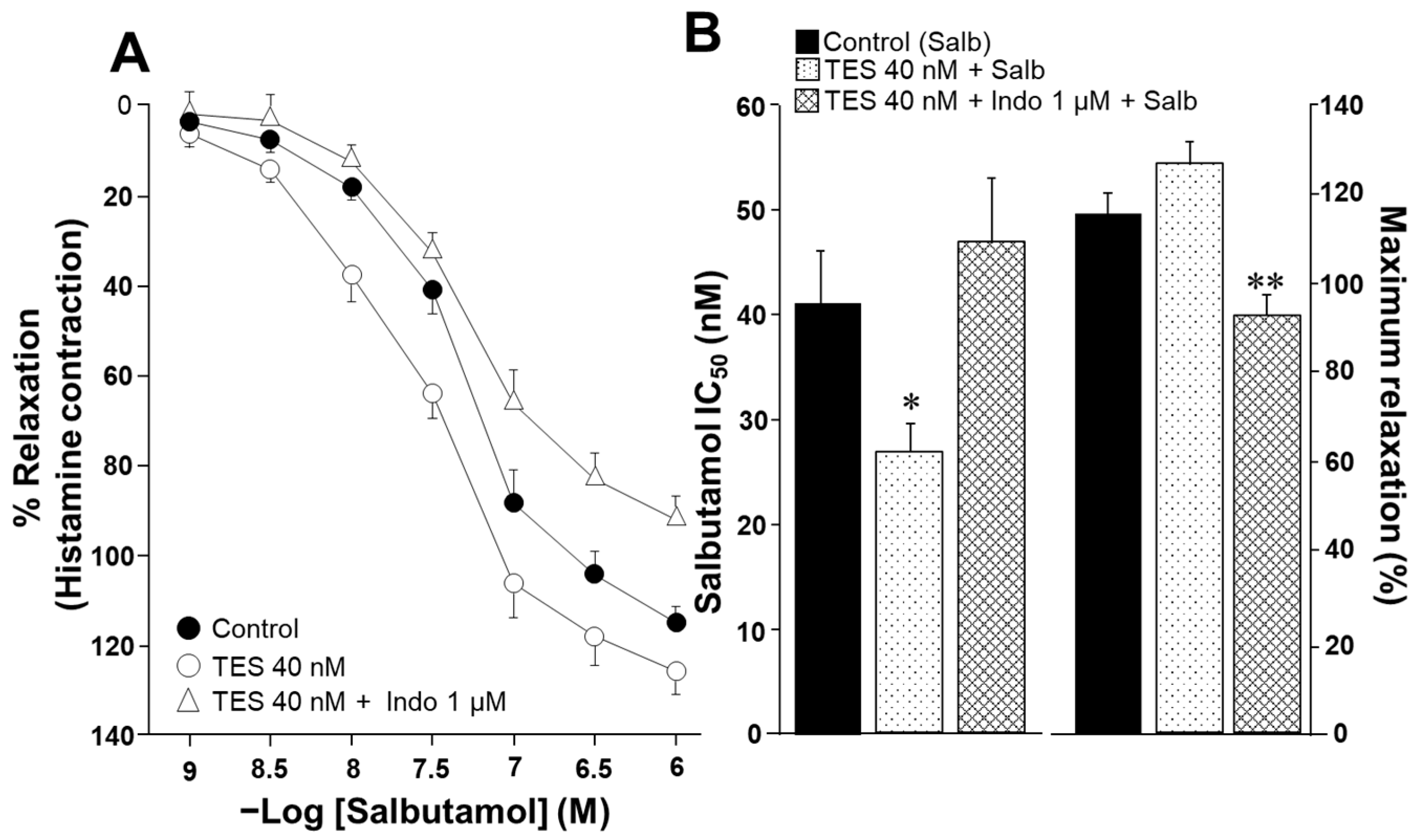
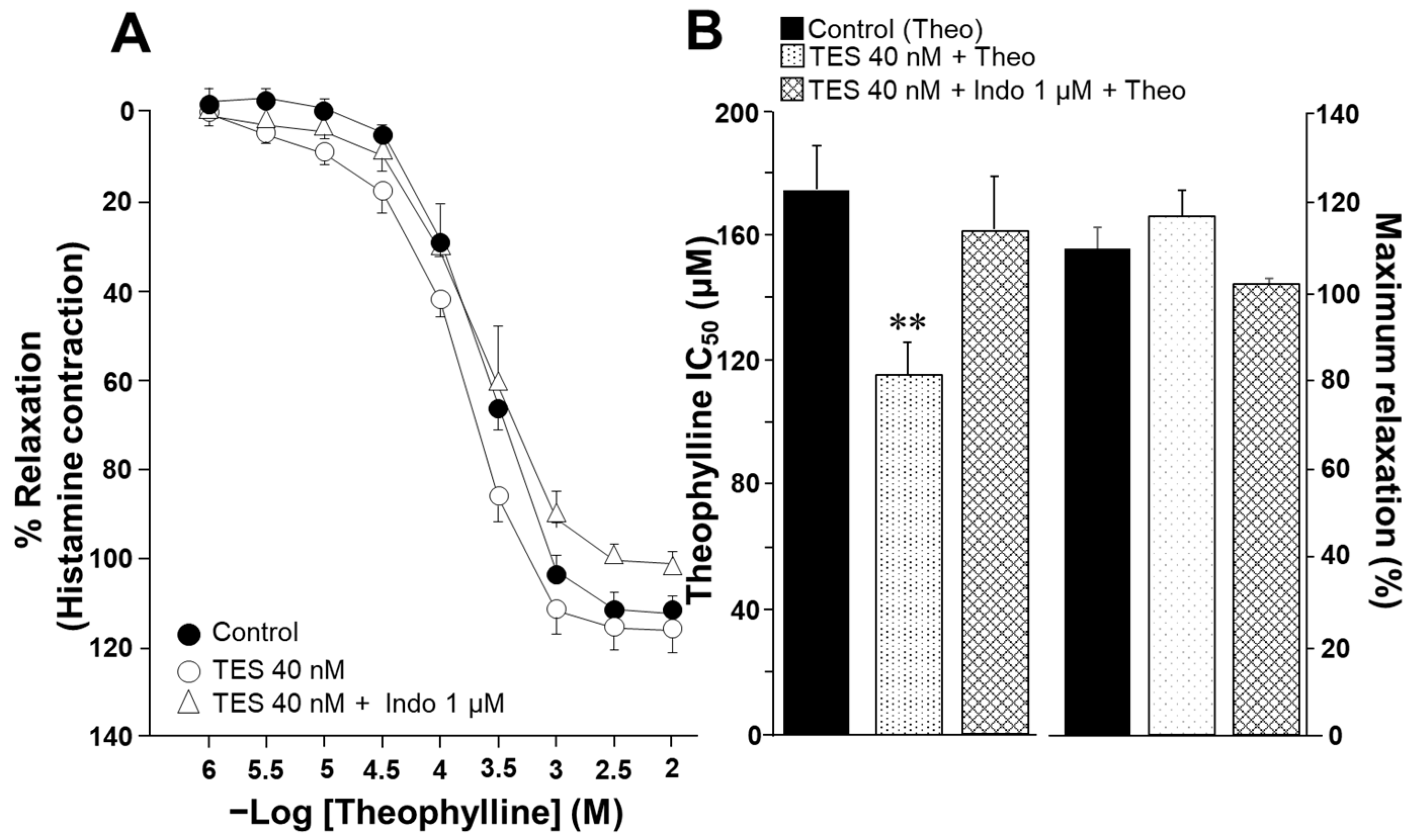
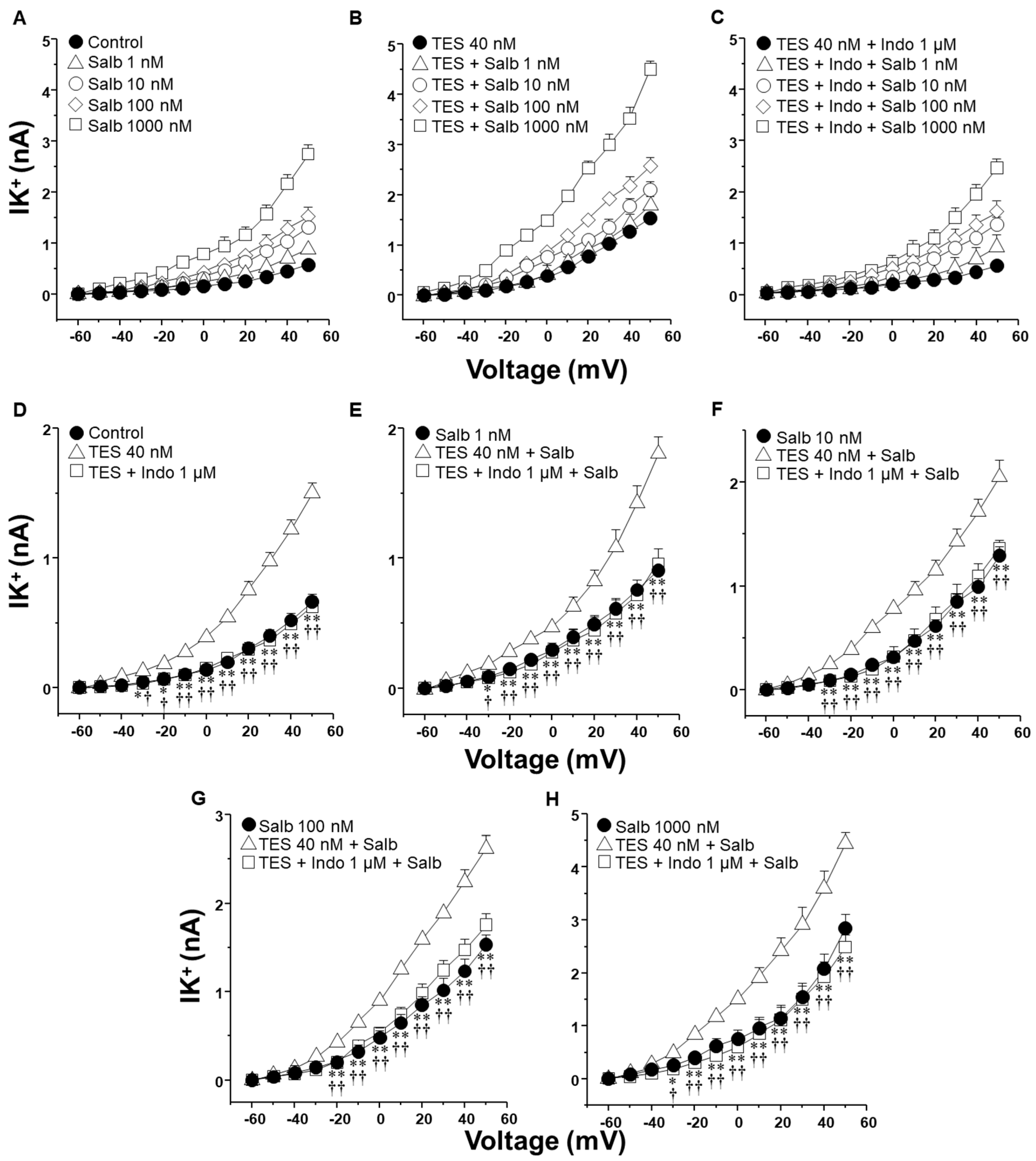
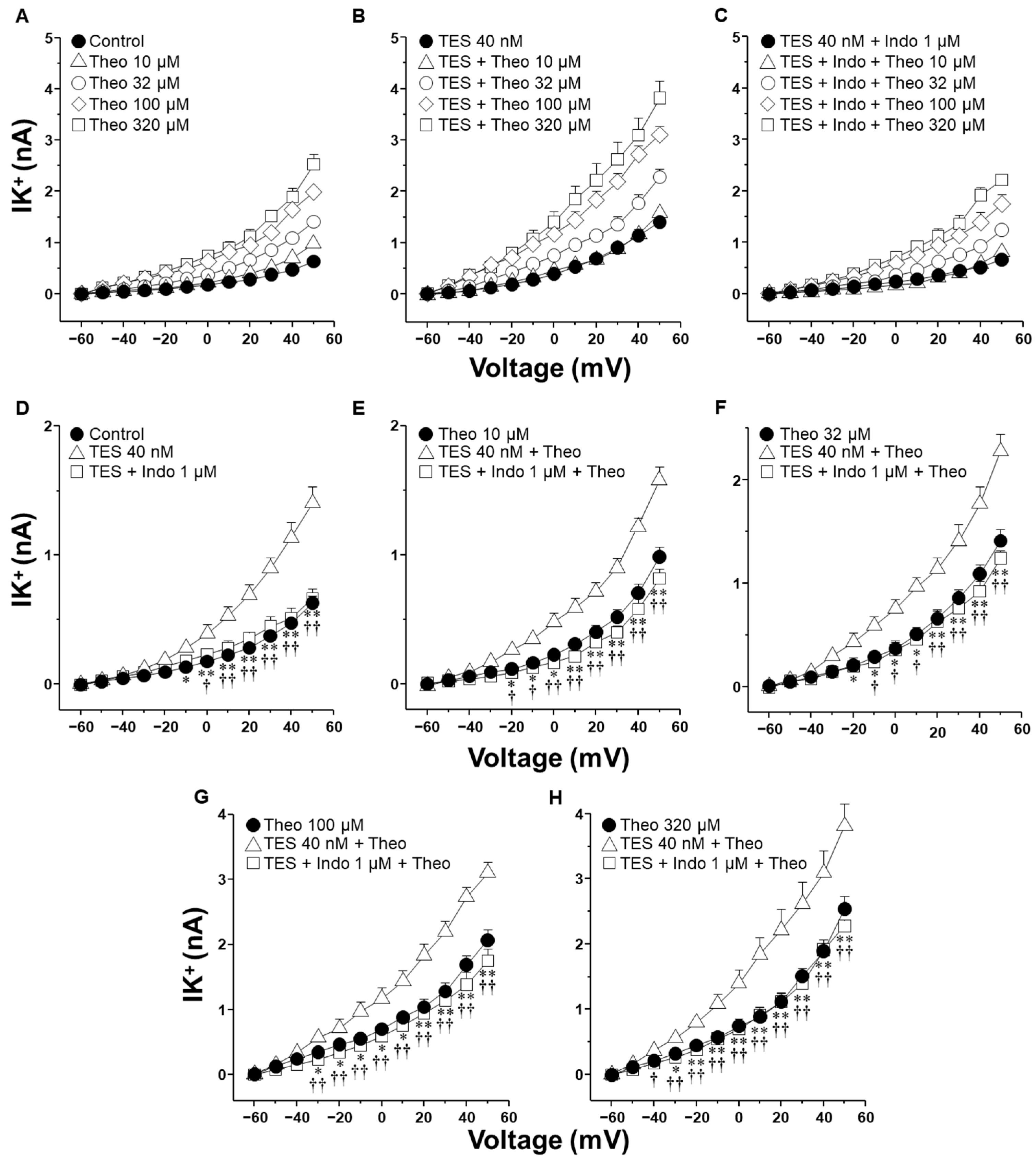
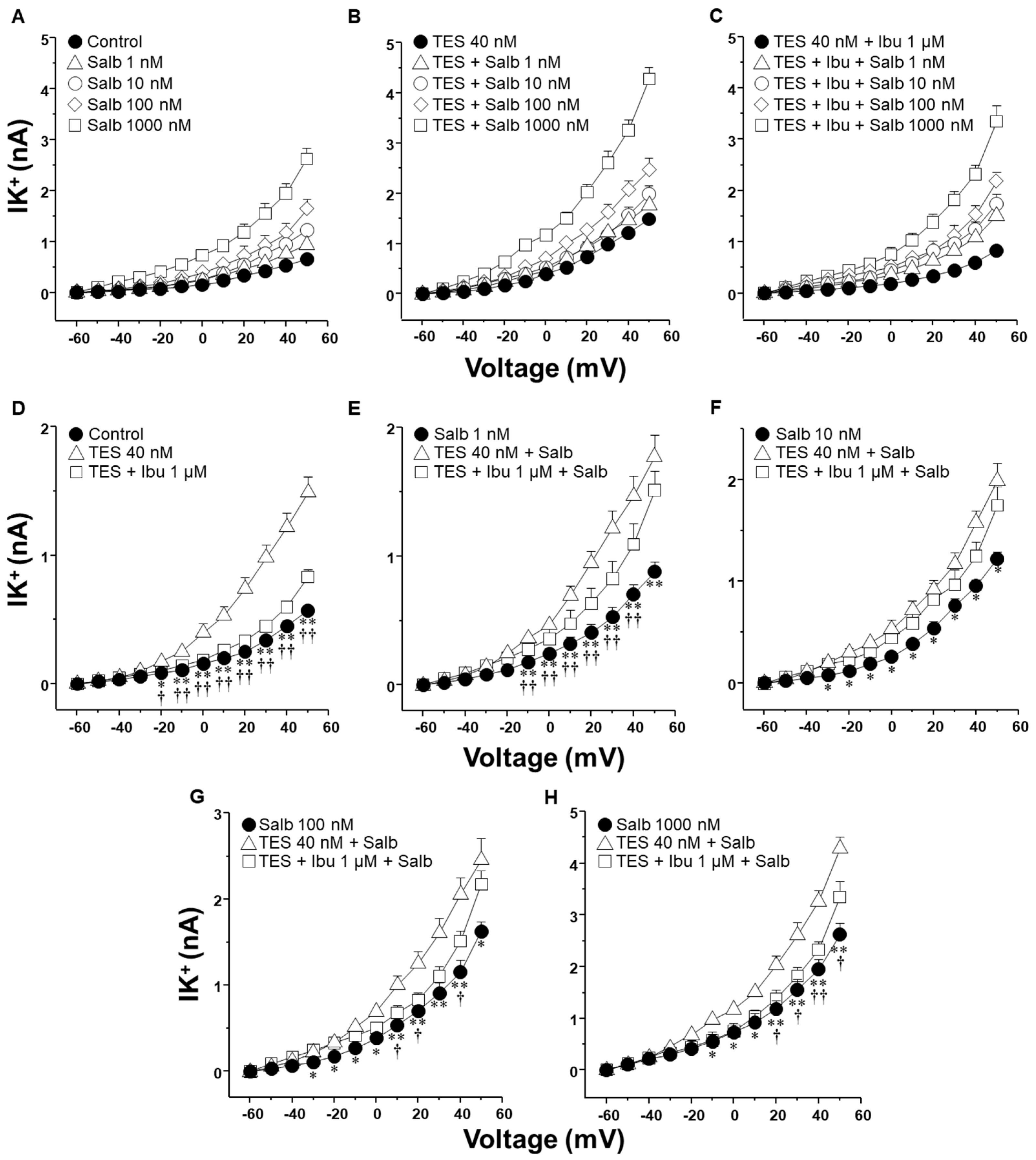
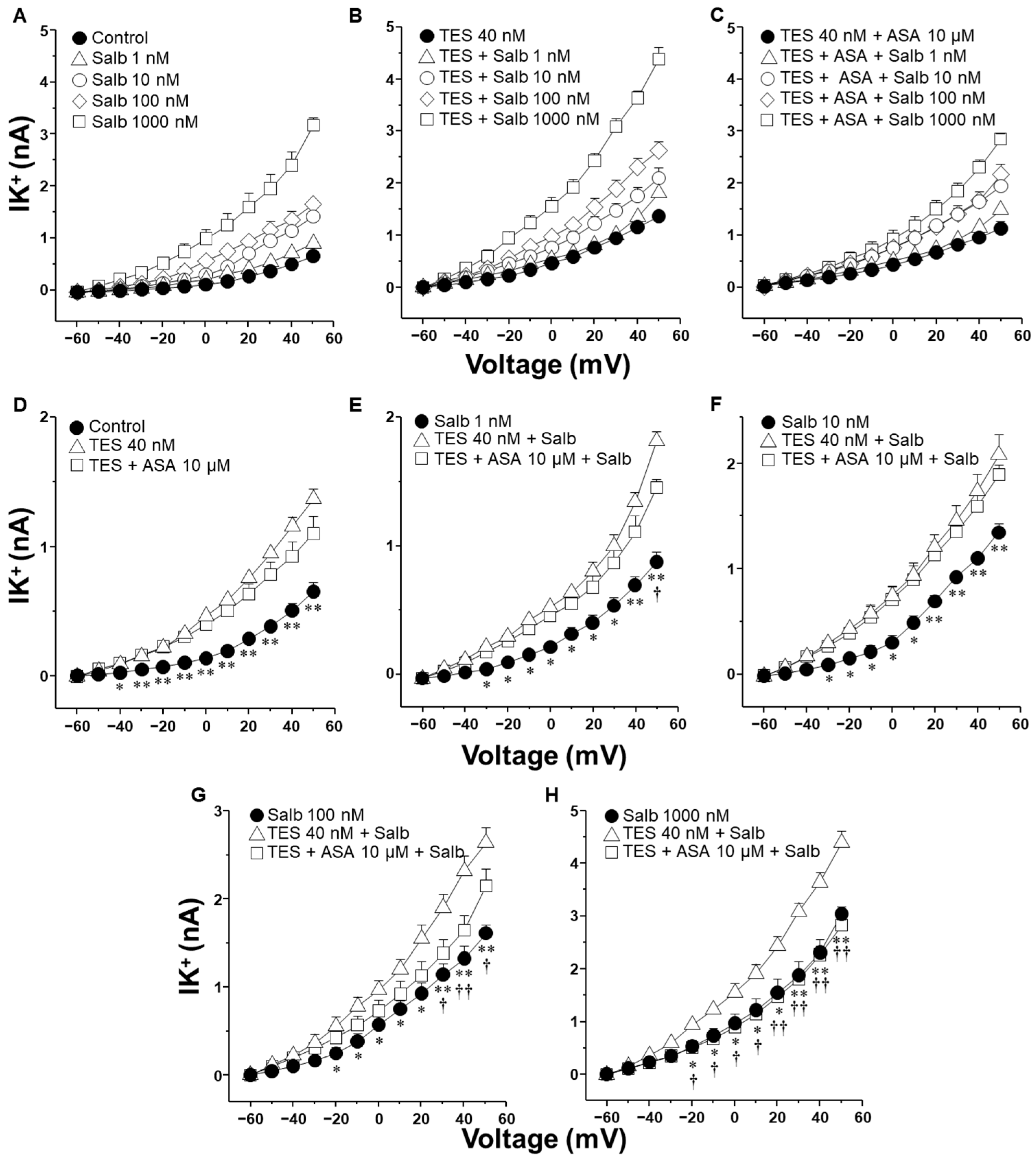


Disclaimer/Publisher’s Note: The statements, opinions and data contained in all publications are solely those of the individual author(s) and contributor(s) and not of MDPI and/or the editor(s). MDPI and/or the editor(s) disclaim responsibility for any injury to people or property resulting from any ideas, methods, instructions or products referred to in the content. |
© 2025 by the authors. Licensee MDPI, Basel, Switzerland. This article is an open access article distributed under the terms and conditions of the Creative Commons Attribution (CC BY) license (https://creativecommons.org/licenses/by/4.0/).
Share and Cite
Reyes-García, J.; Carbajal-García, A.; Díaz-Hernández, V.; Casas-Hernández, M.F.; Montaño, L.M. Indomethacin Abolishes the Potentiation Effect of Testosterone on the Relaxation Induced by Salbutamol and Theophylline by Directly Blocking the K+ Channels in Airway Smooth Muscle. Molecules 2025, 30, 2259. https://doi.org/10.3390/molecules30112259
Reyes-García J, Carbajal-García A, Díaz-Hernández V, Casas-Hernández MF, Montaño LM. Indomethacin Abolishes the Potentiation Effect of Testosterone on the Relaxation Induced by Salbutamol and Theophylline by Directly Blocking the K+ Channels in Airway Smooth Muscle. Molecules. 2025; 30(11):2259. https://doi.org/10.3390/molecules30112259
Chicago/Turabian StyleReyes-García, Jorge, Abril Carbajal-García, Verónica Díaz-Hernández, María F. Casas-Hernández, and Luis M. Montaño. 2025. "Indomethacin Abolishes the Potentiation Effect of Testosterone on the Relaxation Induced by Salbutamol and Theophylline by Directly Blocking the K+ Channels in Airway Smooth Muscle" Molecules 30, no. 11: 2259. https://doi.org/10.3390/molecules30112259
APA StyleReyes-García, J., Carbajal-García, A., Díaz-Hernández, V., Casas-Hernández, M. F., & Montaño, L. M. (2025). Indomethacin Abolishes the Potentiation Effect of Testosterone on the Relaxation Induced by Salbutamol and Theophylline by Directly Blocking the K+ Channels in Airway Smooth Muscle. Molecules, 30(11), 2259. https://doi.org/10.3390/molecules30112259




